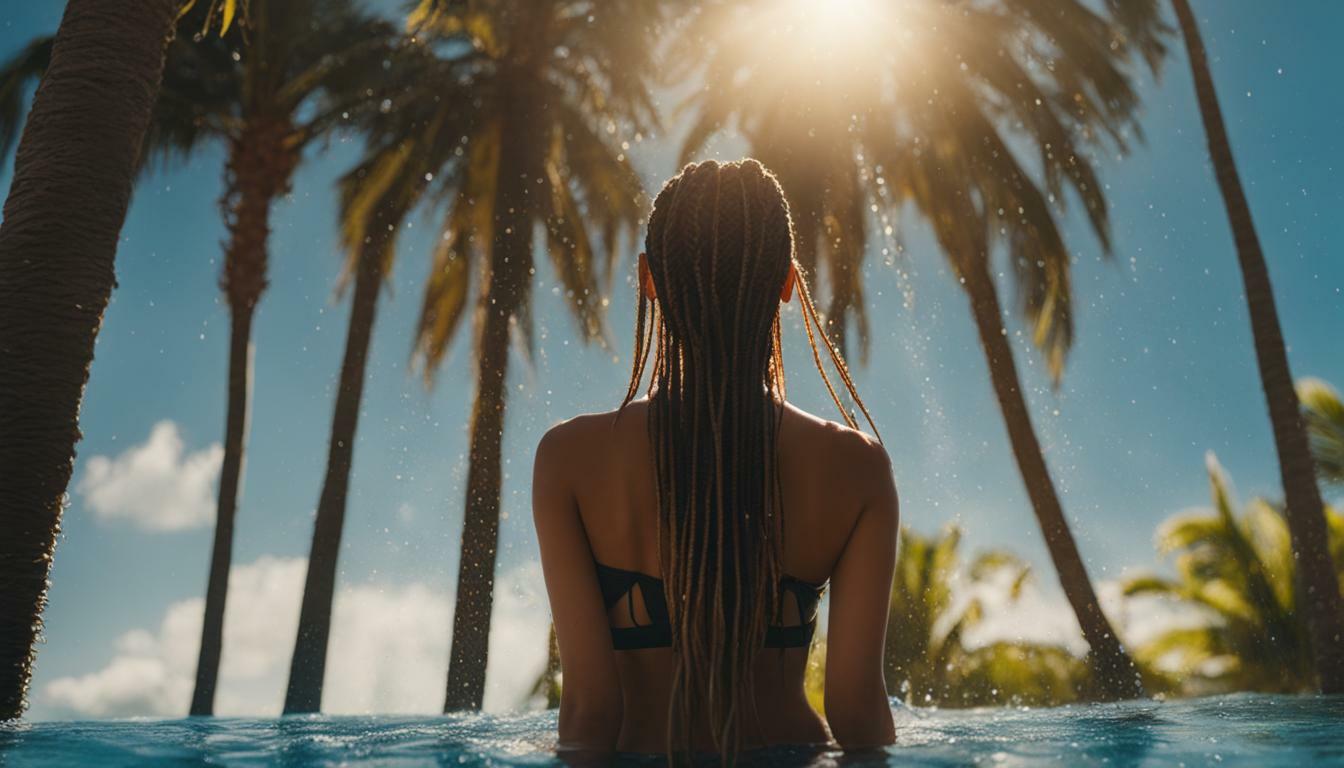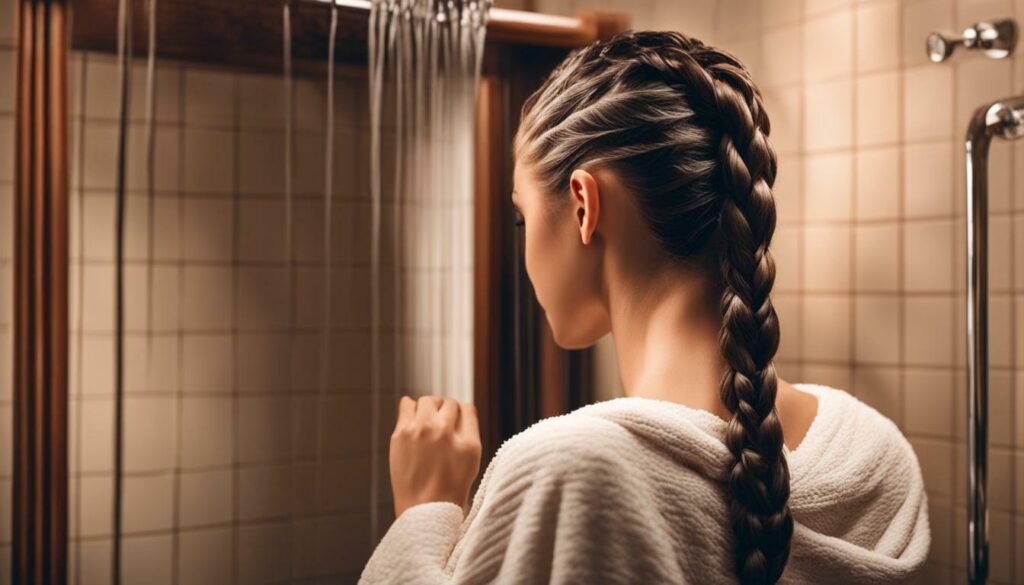
Many people wonder if it’s okay to get their braids wet, especially if they have natural or synthetic braids. The good news is that you can, but it’s important to take certain precautions to ensure the longevity and health of your braided hairstyle.
Wetting braids comes with potential risks such as fungal growth, hair damage, frizz, and unraveling. To minimize these risks, follow these simple tips for caring for wet braids:
- Choose braided styles that can handle water.
- Wet your braids with clean water before swimming.
- Rinse your braids with shampoo and a leave-in conditioner after swimming.
- Consider wearing a swim cap to protect your braids from excessive water exposure.
- Use diluted shampoo to wash your braids.
- Massage the roots and length of the braids while washing.
- Rinse thoroughly to remove all shampoo and conditioner.
- Dry your braids properly using a large microfiber towel, air-drying, or a blow-dryer on a cool setting.
- Avoid tying wet or damp braids in a ponytail or bun.
- Maintain a healthy scalp and avoid overwashing and using excessive products.
By following these tips, you can ensure that your braids stay looking fresh and beautiful for longer. Remember, proper care is key to maintaining the health of your hair and scalp while enjoying the convenience and style of braided hair.
Tips for Caring for Wet Braids
To ensure that your braids stay intact and healthy when wet, there are a few important steps and precautions you should follow. Wet braids are prone to damage and frizz, so it’s crucial to take care of them properly.
1. Choose braided styles that can handle water
Before getting your braids done, discuss with your stylist the type of hair and braiding technique that can withstand water. Synthetic braids are generally more resistant to water, while natural braids may require extra care and precautions.
2. Wet your braids before swimming
Prior to taking a dip, wet your braids with clean water. This helps to prevent chlorine or saltwater from being absorbed into the braids, which can cause damage and drying. It also reduces the risk of the braids becoming too heavy when soaked in water.
3. Rinse your braids after swimming
After swimming, it’s essential to thoroughly rinse your braids with shampoo and follow up with a leave-in conditioner. This helps to remove any residue or impurities from the water and keeps your scalp and hair healthy. Additionally, using a swim cap can provide added protection and minimize exposure to water.
4. Properly dry your braids
When it comes to drying your braids, it’s important to avoid rubbing or wringing them, as this can cause frizz and damage. Instead, gently towel-dry your braids using a large microfiber towel. Alternatively, you can let them air-dry naturally or use a blow-dryer on a cool setting.
Remember, never tie wet or damp braids in a ponytail or bun, as this can lead to breakage and unraveling. Allow your braids to fully dry before styling or tying them up.
By following these tips and taking proper care of your wet braids, you can maintain the integrity of your hairstyle and keep it looking fresh for longer. Remember to maintain a healthy scalp, avoid overwashing, and use minimal products to maximize the lifespan of your braids.

Taking care of your braids when wet is crucial for maintaining their longevity and keeping them looking fresh. Wet braids are susceptible to various issues such as fungal growth, hair damage, frizz, and unraveling. To ensure your braids stay in optimal condition, it’s important to follow a few key precautions and incorporate proper care techniques into your routine.
When choosing a braided style, opt for one that can handle exposure to water. This will greatly reduce the risk of damage and help maintain the integrity of your braids. Before swimming, wet your braids thoroughly with clean water. This will help to minimize chlorine or saltwater absorption, which can cause dryness and lead to breakage.
After swimming, it’s essential to rinse your braids with a shampoo specifically formulated for braided hairstyles. This will help remove any residue or chemicals and ensure your scalp remains clean and healthy. Follow up with a leave-in conditioner to provide added moisture and nourishment to your braids.
When washing your braids, be sure to dilute your shampoo to minimize the risk of product buildup. Gently massage the roots and length of the braids to cleanse them thoroughly. Rinse your braids with lukewarm water until all the shampoo is removed. To dry your braids, avoid vigorous rubbing that can cause frizz and damage. Instead, gently pat them dry using a large microfiber towel or allow them to air dry. If you prefer to use a blow-dryer, set it to the cool setting to minimize heat damage.
Lastly, it’s important to avoid tying wet or damp braids in a ponytail or bun. This can lead to excessive tension and breakage. Instead, allow your braids to dry completely before styling. Additionally, maintaining a healthy scalp is vital for the longevity of your braids. Avoid overwashing and using excessive products that can weigh down your braids and cause buildup. By following these tips and incorporating proper care into your routine, you can prolong the lifespan of your braids and keep them looking fresh.
FAQ
Can I get my braids wet?
Yes, you can get your braids wet, but it’s important to take certain precautions.
What risks are associated with wet braids?
Wet braids are at risk for fungal growth, hair damage, frizz, and unraveling.
What can I do to protect my wet braids?
It’s recommended to choose braided styles that can handle water, wet your braids with clean water before swimming, rinse them afterward with shampoo and a leave-in conditioner, and consider wearing a swim cap.
How should I wash my braids?
When washing braids, use diluted shampoo, massage the roots and length of the braids, rinse thoroughly, and dry them properly by using a large microfiber towel, air-drying, or using a blow-dryer on a cool setting. Avoid tying wet or damp braids in a ponytail or bun.
What is important to remember for overall braids maintenance?
It’s important to maintain a healthy scalp and avoid overwashing and using excessive products. Proper care can help prolong the lifespan of your braids and keep them looking fresh.






